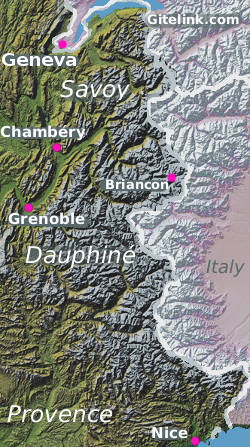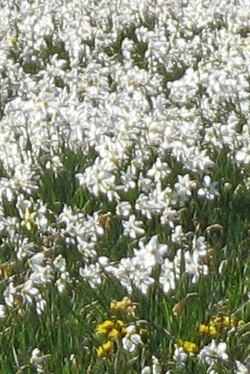
Climate & weather in the French Alps |

| Gitelink France | French route maps | About- France .com |

Weather in the French Alps
Alpine climate - winter and summer

Annual climate and weather in the French Alps The Northern French Alps Exposed to westerly winds blowing in off the Atlantic, the northern French Alps can receive a lot more snow in winter than areas further to the east, which benefit from a drier colder continental climate. This means that in winter, ski resorts in the Savoy Alps, above an altitude of 1500 metres, almost always have snow, often from quite early in the season, particularly if there are prolonged periods of precipitation coming in off the Atlantic. It also means that in the event of milder air coming in off the Atlantic, the snowline in the northern French Alps can easily rise to well above 1000 metres, even in January. But with many resorts offering slopes at over 2000 metres and up to 3000 metres in some cases, this is not a major problem for winter sports enthusiasts. The resort of Val Thorens, for instance, is a resort with guaranteed snow thoroughout the season, lying as it does at an altitude of 2300 m. In the summer months, the northern French Alps enjoy a warm temperate climate, with enough rainfall, often in the form of summer storms, to keep the landscape green and luxuriant. Above an altitude of about 1000 metres, Alpine meadows and pastures offer rich grazing lands for cattle, and magnificent displays of wild flowers, including vast swathes of wild daffodils or wild narcissi. Temperatures and rainfall: Average July daily high temperatures in Annecy, altitude 450 m, are 26�C (79.F), and annual rainfall or snowfall is 133 cm:. In this part of the Alps, the rainiest month of the year is August - much of the rain falling in the form of heavy rainstorms. There is considerably less rain in May and October
The southern Alps The southern part of the French Alps is a generally dry area. However the highest areas receive sufficient snow in winter to provide excellent skiing conditions at resorts such as Isola 2000, which lies just 90 km from the Mediterranean. Being drier, the southern Alps also benefit from plenty of sunshine, throughout the year. This is one of the sunniest areas in Europe, with generally over 2500 hours of sunshine per year throughout the area. The area records only about 90 days of rainfall a year, much of the rain falling in the form of short heavy showers. Temperatures and rainfall: Average July daily high temperatures in Brianïçon, altitude 1326 m, are 27°C (81°F) , and the town boasts 300 days of sunshine a year: however the dry climate and the altitude mean that nights are cool; night time lows average 10° in May, and are back down to 13° in October. Rain patterns in Briancon are rather different to those in Annecy; July, with 5.6 cm of rain, is the driest month of the year apart from the winter months; May is the wettest month, with 10.7 cm of rain. |
|


Copyright notice:
Website and text copyright Gitelink.com 2007-2024
Photos copyright Gitelink com